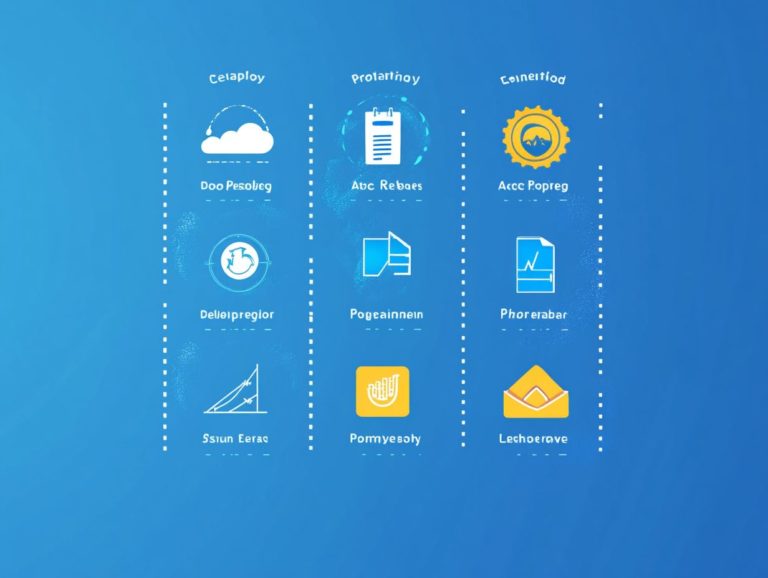the role of forensics in incident response
In today’s digital landscape, mastering effective incident response is crucial for safeguarding sensitive information and upholding organizational integrity. Are you ready to protect your organization from cyber threats?
This article dives into the fundamental principles of incident response, with a spotlight on the pivotal role of digital forensics. You’ll discover key concepts and a detailed outline of the steps involved in collecting and analyzing evidence.
We’ll explore how forensics can significantly enhance both accuracy and security measures.
Throughout this journey, you ll encounter inherent challenges in this field and gain insightful strategies to overcome them. Join us as we reveal the vital connection between incident response and digital forensics.
Contents
- Key Takeaways:
- The Basics of Incident Response
- The Role of Forensics in Incident Response
- Key Steps in Using Forensics for Incident Response
- Benefits of Incorporating Forensics in Incident Response
- Challenges and Limitations of Using Forensics in Incident Response
- Frequently Asked Questions
- What is the role of forensics in incident response?
- Why is forensics important in incident response?
- What types of evidence can be collected through forensic analysis in incident response?
- How Does Forensics Help in Incident Response Investigations?
- What Are Common Tools and Techniques in Forensics?
- How Can Organizations Prepare for Forensics in Their Incident Response Plan?
Key Takeaways:

- Digital forensics enhances incident response by allowing for the accurate and efficient collection and analysis of evidence, leading to faster resolution of security incidents.
- Incorporating digital forensics in incident response enhances security measures and helps prevent future cyber attacks.
- Potential obstacles in using digital forensics for incident response can be overcome with proper training and collaboration among cybersecurity professionals.
The Basics of Incident Response
Incident response is an essential process in cybersecurity that requires attention to preparation, detection, analysis, and remediation of security incidents. It is structured to protect your organization s IT infrastructure and focuses on restoring operations while minimizing damage.
By implementing a robust incident response plan, you equip yourself with the tools needed to address data breaches and other cybersecurity incidents effectively. This helps you respond swiftly and strengthens your overall security posture through proactive measures and a commitment to continuous improvement.
Definition and Objectives
Incident response involves a systematic approach to managing and addressing cybersecurity incidents, ensuring your organization is well-prepared to tackle potential threats.
With a structured incident response plan, you aim to minimize damage from cyber threats, preserve essential evidence for future analysis, and maintain business continuity during disruptions.
Proactively identifying and managing incidents mitigates immediate impacts and plays a crucial role in reducing overall risk exposure. A well-executed response strategy enhances your organization s cybersecurity readiness, equipping you to learn from past breaches and continuously improve your defenses.
Effective incident responses can foster a culture of cybersecurity awareness, building resilience and encouraging best practices throughout all levels of your organization.
The Role of Forensics in Incident Response
Digital forensics is an essential cornerstone in incident response, enabling you to collect and analyze digital evidence vital for understanding the role of incident response in business continuity and the impact of security incidents.
By employing a structured approach, digital forensics reveals critical insights into the methodologies of threat actors and the scope of any data breaches.
This knowledge enables your organization to develop more effective containment and remediation strategies, enhancing your overall security posture.
What is Digital Forensics?
Digital forensics is a highly specialized branch of forensic science that focuses on recovering, analyzing, and presenting data stored on digital devices while ensuring the integrity of the evidence throughout the process.
This field is guided by core principles, such as preserving data integrity and implementing methodological frameworks that assist investigators.
It encompasses a wide range of digital devices, including computers, smartphones, and tablets, each requiring tailored techniques for effective extraction and analysis.
By maintaining a proper chain of custody, digital forensics professionals ensure that evidence remains admissible in court, which is essential for prosecuting cybercriminals.
However, the role of digital forensics extends beyond merely solving crimes; it is crucial in managing security incidents, assisting organizations in understanding breaches, and developing strategies to protect sensitive information.
In conclusion, mastering incident response and digital forensics is essential for any organization. By implementing what you’ve learned, you can significantly improve your security measures. Act now to enhance your defenses!
Why is it Important in Incident Response?

The importance of digital forensics in incident response is profound. It offers actionable insights that deepen your understanding of cybersecurity incidents and their potential impact on your organization’s security posture, especially when considering understanding legal issues in incident response.
By carefully examining data breaches and unauthorized access attempts, digital forensics allows you to identify security gaps that might have otherwise gone unnoticed. This meticulous examination reveals the progression of a cyberattack and helps you evaluate the overall effects of the incident on your systems and data integrity.
The insights gained from these investigations are crucial for creating strong recovery strategies that will help you bounce back quickly. With this knowledge in hand, your threat intelligence is greatly enhanced, equipping your team with the expertise needed to mitigate future risks and fortify defenses against ever-evolving cyber threats.
Key Steps in Using Forensics for Incident Response
Integrating digital forensics into your incident response process involves several crucial steps that significantly enhance your organization’s capability to address and mitigate security incidents effectively, particularly by understanding the role of leadership in incident response.
These steps include the meticulous collection and analysis of evidence, yielding vital insights into the nature of the incident. This helps you decide on containment and response strategies.
Collecting and Analyzing Evidence
Collecting and analyzing evidence is a fundamental aspect of digital forensics. This process allows you to uncover the intricate details surrounding cybersecurity incidents.
To effectively carry out this process, you ll employ various methodologies, underscoring the importance of preserving digital artifacts in their original state. Each piece of data be it logs, files, or network packets plays a crucial role in assembling the narrative of the incident.
Maintaining a chain of custody the process of keeping evidence secure to prevent tampering is vital to ensure the integrity of the evidence. Thorough log analysis becomes an invaluable tool for identifying the origins of incidents, enabling you to spot patterns of threats that may have slipped under the radar.
By meticulously examining these logs, you can trace the actions of malicious actors, ultimately fortifying your defenses against future breaches.
Identifying the Source of the Incident
Identifying the source of a cybersecurity incident is a crucial step in your incident response process. It offers valuable insights into the tactics and motivations of threat actors.
By utilizing techniques like analyzing data packets, log analysis, and monitoring user interactions, you can construct a detailed timeline of the event, revealing the methods employed by the attackers.
Understanding the origin helps you pinpoint the vulnerabilities that were exploited and uncovers the broader implications of the breach. This enables you to tailor your containment strategies effectively.
When you recognize the specific techniques and tools used in the attack, it becomes possible to strengthen your defenses, implement targeted countermeasures, and develop comprehensive incident response plans that minimize the risk of future attacks.
Benefits of Incorporating Forensics in Incident Response
Incorporating digital forensics into your incident response strategy offers numerous advantages.
It increases accuracy in identifying threats and strengthens your security measures, effectively fortifying your organization s defenses against future cyberattacks.
By leveraging these advanced techniques, you not only improve your immediate response but also establish a solid foundation for long-term cyber resilience.
Improved Accuracy and Efficiency

Achieving better accuracy and efficiency in your incident response processes means using digital forensics step by step. This approach helps your organization effectively tackle cybersecurity incidents.
With sophisticated techniques to uncover relevant evidence, digital forensics enables you to swiftly identify the source and impact of breaches.
For instance, if your company faces a data leak, your ability to quickly recover lost information and analyze it provides crucial insights. These insights could help prevent future incidents.
The timely analysis of digital evidence streamlines your investigation process and facilitates knowledge-based decision-making. This results in enhanced security measures, equipping your organization to mitigate risks, respond to threats, and maintain integrity in a competitive landscape.
Enhanced Security Measures
Integrating digital forensics into your incident response strategy leads directly to enhanced security measures, ultimately resulting in a stronger cybersecurity posture.
By meticulously analyzing incidents, you extract valuable insights that guide the creation of improved security protocols. These findings help identify vulnerabilities and enable proactive measures to fend off potential threats.
Insights from security alerts become crucial components in your comprehensive security planning. This ensures you’re prepared to adapt and respond swiftly to evolving risks.
This proactive mindset not only strengthens defenses but also nurtures a resilient framework. Security practices are continually refined, fostering a culture of vigilance and preparedness throughout your organization.
Challenges and Limitations of Using Forensics in Incident Response
Despite the advantages of digital forensics in incident response, several challenges and limitations may impede your forensic investigations.
Potential Obstacles and How to Overcome Them
Potential obstacles may include challenges in preserving evidence and issues with existing security protocols that might not fully support forensic investigations. These complications can significantly hinder your organization’s ability to respond effectively, often resulting in incomplete data collection or contamination of vital evidence.
To overcome these challenges, enhance your evidence preservation methods through standardized procedures. Implement clear guidelines regarding the chain of custody and invest in tools that automate data collection processes.
Fostering improved communication between cybersecurity teams and forensic investigators bridges knowledge gaps. Regular joint training sessions can further enhance collaboration, making your incident response more efficient and effective.
Frequently Asked Questions
What is the role of forensics in incident response?

The role of forensics in incident response is to collect and analyze digital evidence related to a security incident. Understanding the role of threat intelligence in incident response can further help identify the cause and extent of the attack, aiding in remediation and prevention efforts.
Why is forensics important in incident response?
Forensics is essential because it allows a thorough examination of the digital environment. This reveals important details about incidents and provides guidance on preventing similar attacks in the future.
What types of evidence can be collected through forensic analysis in incident response?
Forensic analysis can yield a range of evidence, including network logs, system logs, memory images, file system artifacts, and even deleted files. This evidence helps determine the origin, scope, and impact of incidents.
How Does Forensics Help in Incident Response Investigations?
Forensics is essential in incident response investigations. It provides evidence to identify the attacker, understand how the attack happened, and measure the damage. Understanding the role of technology in incident response can further enhance these efforts.
What Are Common Tools and Techniques in Forensics?
Common tools include network analysis, memory analysis, malware analysis, and data recovery techniques. These help investigators gather and analyze evidence to reconstruct the incident.
How Can Organizations Prepare for Forensics in Their Incident Response Plan?
Organizations should conduct regular training and drills. Developing a standard procedure for collecting and analyzing evidence is crucial.
Partnerships with external forensic experts can also enhance preparedness. A clear incident response plan with defined roles for team members is essential.






